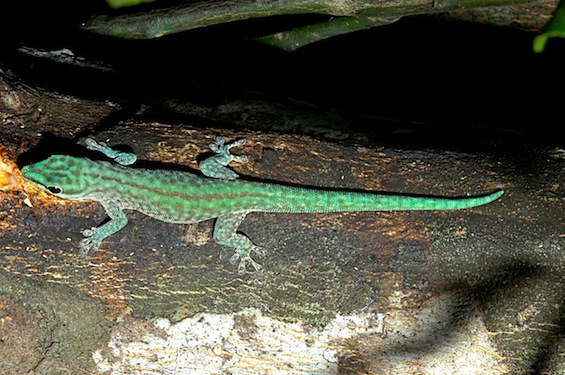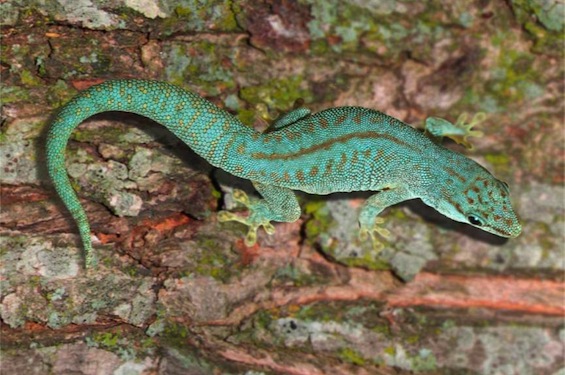Subspecies
Phelsuma abbotti abbotti STEJNEGER, 1893
Phelsuma abbotti chekei (BÖRNER & MINUTH, 1984)
Phelsuma abbotti sumptio CHEKE, 1982
Synomyms
Phelsuma abbotti abbotti (STEJNEGER 1893)
Phelsuma abbotti STEJNEGER 1893: 716
Phelsuma madagascariensis var. abbotti — BOULENGER 1911: 378
Phelsuma abbotti — WERMUTH 1965: 126
Phelsuma abbotti — KLUGE 1993
Phelsuma abbotti — D’CRUZE et al. 2007
Phelsuma abbotti abbotti STEJNEGER, 1893
Synonyms
Phelsuma abbotti abbotti STEJNEGER, 1893
Phelsuma madagascariensis abbotti — LOVERIDGE 1942: 465
Phelsuma abbotti abbotti — MERTENS 1962: 84
Phelsuma abbotti abbotti — BERGHOF 2005
Distribution
Phelsuma abbotti abbotti only occurs on the Aldabra atol, one of the last virgin islands in the world whose terrestrial (and marine) environment represent an almost untouched ecosystem. Aldabra is located 1150 km south of Mahé (Seychelles), 640 km east of mainland Africa and 400 km north of Madagascar.
Terra Typica
Aldabra Island, Seychelles
Localities
Aldabra
Phelsuma abbotti chekei (BÖRNER & MINUTH, 1984)

Image © Emmanuel Van Heygen
Synonyms
Phelsuma abbotti chekei (BÖRNER & MINUTH 1984)
Phelsuma chekei BÖRNER & MINUTH 1984
Phelsuma befotakensis BÖRNER & MINUTH 1982 (fide MEIER & BÖHME)
Phelsuma abbotti chekei — GLAW & VENCES 1994: 290
Phelsuma abbotti chekei — BERGHOF 2005
Phelsuma abbotti chekei — SCHÖNECKER & SCHÖNECKER 2010
Description
The coloration of P. abbotti chekei varies from one individual to the other. It ranges from blue to green or grey, with marbled flanks and legs. The dorsal pattern consists of red-brown dots and sometimes a median vertebral line is present. It is a medium sized species that reaches lengths up to 145 mm, the females are generally a little smaller and duller in colouration. Two further subspecies are known; Phelsuma abbotti abbotti (Stejneger, 1893) from the Aldabra Atoll, Seychelles and Phelsuma abbotti sumptio (Cheke, 1982) from Assumption Island, Seychelles.
Distribution
Their distribution range is for a Malagasy form quite extensive, it occurs along Madagascar’s western coast from Antsiranana in the north, as far south as Antsalova. Phelsuma abbotti chekei occurs along the north-western coast of Madagascar, including the Ampasindava peninsular and the islands Nosy Bé, Nosy Komba and Nosy Mamoko. The record from Sambava (Eastern Madagascar) is probably incorrect and mistaken for Phelsuma masohoala. The most southern record is from Soalala in western Madagascar and the distribution reaches as far north as Antsiranana (Terra Typica).
Terra Typica
Diégo Saurez (Antsiranana)
Localities
Ambatoloaka, Ambilobe, Antsalova, Antsiranana, Befotaka, Kongony, Mahajanga, Nosy Mamoko, Soalala
Biotope
Phelsuma abbotti chekei is mainly found on large sun exposed tree trunks outside and at the edge of primary forest patches. On Nosy Be and on the Ampasindava peninsula the species is also found in the coastal mangroves and mangrove trees along swamps and rivers. In western Madagascar, in the seasonal dry forests near Antsalova, the animals are found in the larger deciduous trees. In urban areas like Antsiranana and southern Nosy Be, they can be found on houses and in gardens.
Phelsuma abbotti sumptio CHEKE, 1982

Image © Emmanuel Van Heygen
Synonyms
Phelsuma abbotti sumptio CHEKE 1982
Phelsuma abbotti sumptio — BERGHOF 2005
Distribution
Phelsuma abbotti sumptio only occurs on Assumption Island, 40 km south of the Aldabra atoll. The island is one of the four members of the Aldabra Group, Seychelles.
Terra Typica
Assumption Island, Seychelles
Biotope
Phelsuma abbotti sumptio lives on deciduous trees and coconut trees. These trees are more abundant then on the Aldabra atoll. The island prevails a mild, humid climate, due to the warm ocean currents. The temperatures range between 27°C and 30°C and decrease only a little at night.
Description
This subspecies of Phelsuma abbotti is with approx. 15 cm to 16 cm overall length somewhat larger then the nominate and the Madagascar form and is more compact. The basic colour is a mixture of grey and Turkish blue. The very fast colour change abilities of this subspecies makes it possible for the animals to be bright light blue within seconds. The splendour colouring is shown frequently with food intake and with mating or territorial behaviour. As red markings, Phelsuma abbotti sumptio possesses a lip line, which runs from the nose to the eye; an irregular head design, a partially interrupted dorsal line, as well as some scattered points on the back. The scales on the flanks become more coarse-grained and the colouring goes more into the grey. Belly and throat are orange, the lower tail surface grey. The iris is dark-brown. The difference between the sexes exists only in a small size difference and the increased femoral pores of the males.
